About Ragdoll Cats
Ragdoll Introduction
History of the Ragdoll
Ragdolls are a relatively new breed, developed by Ann Baker from Riverside, CA in the 1960's. A pure white, longhaired cat named Josephine was bred to a bicolor male cat named Daddy Warbucks and a black male called, creatively, Blackie. Ann Baker became a ibt erratic as time went on, and her "desciples" split off from her to create what we know today as the Ragdoll Breed. As a new breed, Ragdolls are one of the healthiest breeds of purebred cats, with very little inbreeding.
What makes a Ragdoll, a Ragdoll?
The defining characteristic of Ragdoll cats is their temperament. Like all animals, there is a lot of individual variation between cats, but Ragdolls are known for being mild, docile, sweet tempered nature, and are very human oriented. They get their name from the characteristic "ragdoll flop". When you pick them up, they often go limp like, well, a rag doll! They are infamous for following their people around, wanting to hang out near or on top of them. Many love to play fetch and go on outings on leash. They have absolutely zero dignity and will lie on their backs with legs splayed every which way.
Ragdoll cats are strictly an indoor cat, and should not be outdoors unsupervised. Their mellow temperament also gives them an apalling lack of survival instinct, and they are just as likely to run up to say hi to a coyote or passing car as to a person. Please keep your purebred Ragdoll kitty indoors. Many crossbred raggies, called "moggies", do okay outdoors, so please take your individual cat's temperament into account.
Colors and Markings
Ragdolls come in many colors including seal (black), blue(dilute black or grey), chocolate, lilac, cinnamon, fawn, red and cream along with the tortoiseshell and lynx (or tabby) variations. The breed standard calls for all Ragdolls to be "pointed" cats, which means they carry a modified albinism gene that makes their bodies lighter than their "points" (face, ears, paws, and tail). The coloration is actually affected by temperature, and it takes several years for them to get their full color.
They also come in a few different white patterns. Pointed cats have no white anywhere on their bodies, although they may look white when young. Mitted cats have white front toes, stockings in the back feet, a white chin and white belly stripe. They may have a white strip or blaze on their noses, too! Bicolor cats have more white, with an inverted V on their face, white legs front and back, white belly, and often white breaking into the dark "saddle" on their back.
To show or to fit the breed standard, Ragdoll cats have to fit the breed standard of being a pointed cat with blue eyes, the darker the better. But, because it is a relatively new breed that came from pet cats, there are several other color variations still in the gene pool that can be registered but not shown. This includes mink, sepia, and solid cats with eyes that vary from yellow to a brilliant aquamarine. The goal of the original breeders was to breed these other colors out of the gene pool, but many breeders cherish them and are continuing to breed them. Some are trying to get them accepted into the official Ragdoll Breed Standard. I personally choose to stick with "traditional" ragdoll pointed colors, but there is nothing physically wrong with the other colors.
Ragdoll Coat
The ragdoll coat is medium-long to long. Its defining characteristic is its rabbit-like texture. It is not cottony or wooley like other longhaired cats, and is not always as long as some breeds. It feels, to me, like the coat came from the lovechild of a unicorn and a chinchilla, with a little cloud mixed in. The coat is remarkably low maintainance for a longer haired cat. The outer guard hairs are soft, and the undercoat is minimal on most Ragdolls. Shedding is also minimal except in Spring and Fall, when the loose hairs should be brushed out daily.
Build and Body
The Ragdoll cat is a substantial cat, weighing 11-20lb for males and 9-15lb for females. The body is long and muscular, with proportional legs and nice, thick boning. The face should be a broad modified wedge with smooth contours. They should not have any extreme features. Check out the TICA breed standard for all the boring details! There is a very educational presentation under "seminars" on the TICA website if you click on the button above.
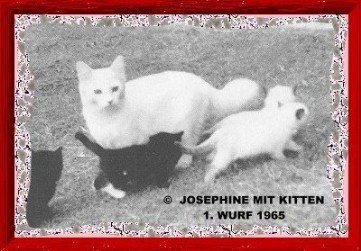

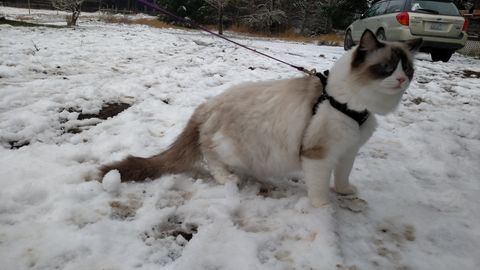
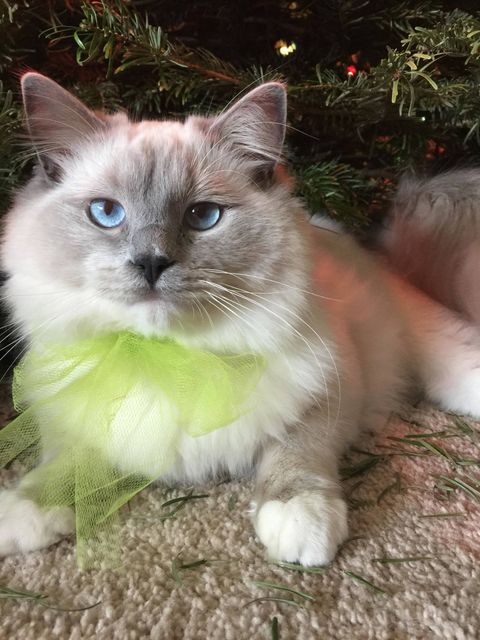
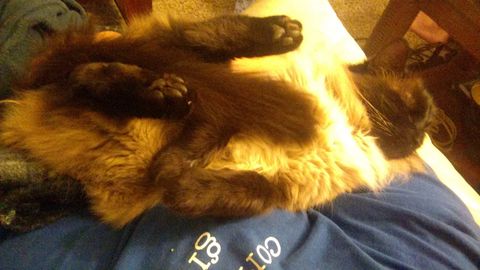

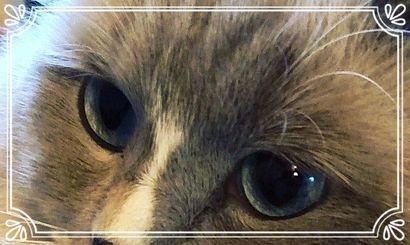
Ragdoll cats should have blue eyes
